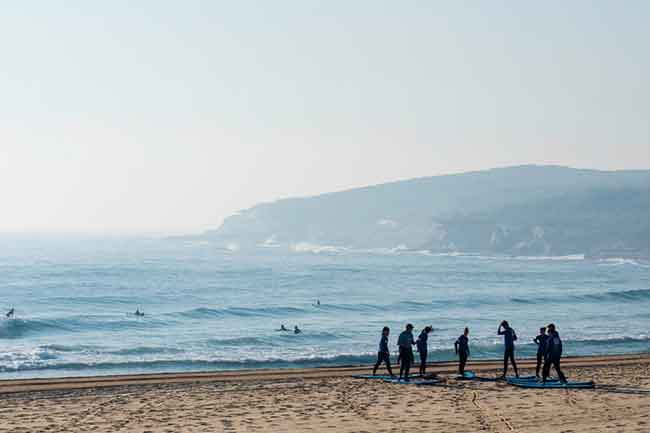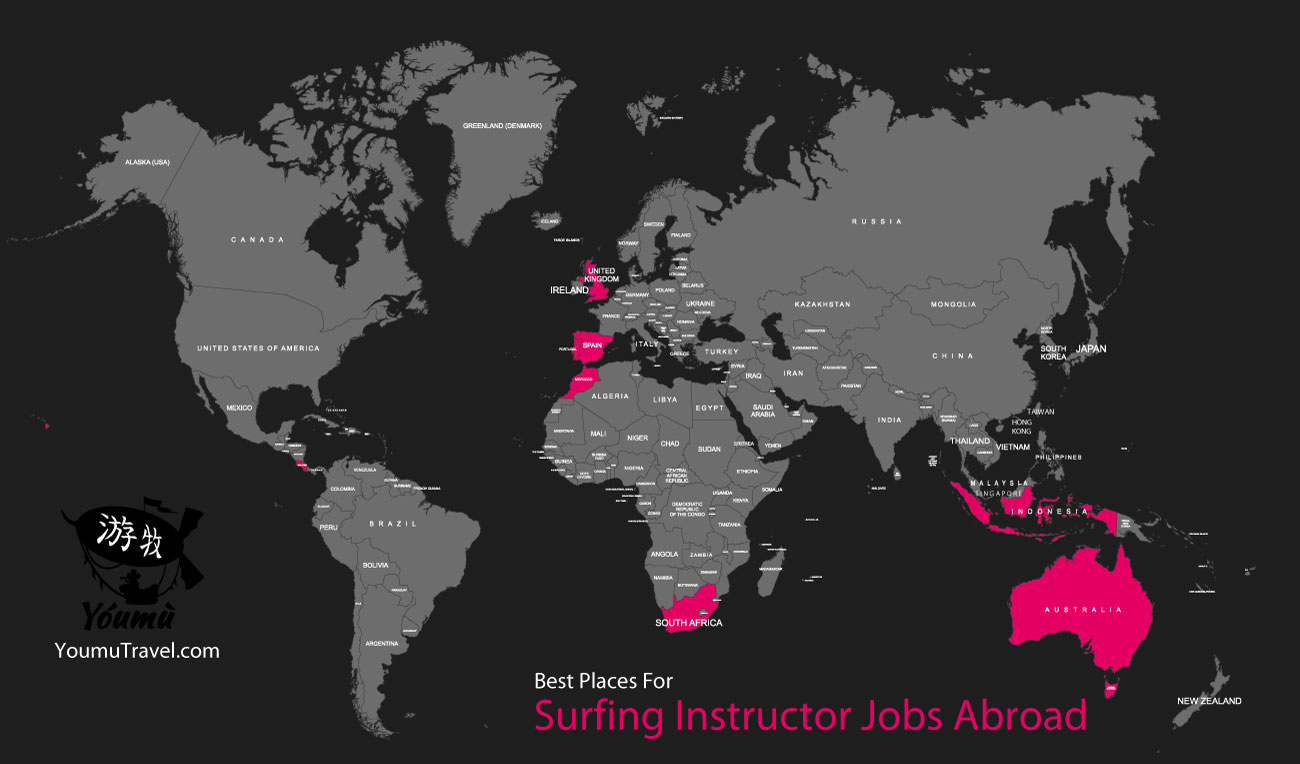Surfing Instructor Jobs Abroad – Guide
A surfing instructor teaches clients of a range of ages on marine safety and the basics of surfing and stand-up paddleboarding around the world.

This job is in somewhat high demand but takes a considerable amount of time and effort to become one.
Demand
- Somewhat High Demand
Experience & Degree
- At least One Year of Experience Required
- Hard Certification Required
- Native English Speaking Preferred
Citizenship
- Some Restrictions
This job is somewhat reliable with reasonable pay but typically not full time.
Pay Range
- Hourly: $10-$25/hr.
Reliability
- Somewhat Reliable
Housing
- Room and Board Sometimes Provided
This job is somewhat flexible with its schedule and location availability.
Location
- Somewhat Flexible
Schedule
- Somewhat Flexible
Language
- Fluency in English
Who can get Surfing Instructor Jobs?
To become a surf instructor, you’ll need to get two certifications: an International Surf Association Level 1 and a lifesaving certification. These are not easy qualifications to obtain so you will need to have been a surfer for quite some time with plenty of experience.
What are the responsibilities for Surfing Instructor Jobs?
The main function of a surfing instructor is to teach students how to surf, but many tasks go into accomplishing this.
Key Responsibilities
- Schedule lessons.
- Sometimes provide wetsuits and equipment, depending on the type of surf school.
- Clean wetsuits and ensure they are in good condition.
- Be professional and welcoming with students.
- Have intermediate surf experience at least, as well as ability in basic turns.
- Teach various surf techniques.
- Keep students well informed on ocean safety and surf etiquette.
- Keep the shop, boardroom, and facilities clean.
What’s the typical schedule for Surfing Instructor Jobs?
The schedule can be pretty flexible so you can choose how many lessons you give, how long the sessions are, and how many people you’ll teach. When working with a company, you’re looking at all-day lessons with breaks in-between.
Income Reliability
In general, being a surf instructor abroad is a reliable job that provides a constant stream of work.
Typical Job Duration
Being a surf instructor abroad can be short-term or long-term.
Estimated Hours Per Week
It’s estimated that you can work full time, 40 hours per week, as an abroad surf instructor.
Room & Board
Being an abroad surf instructor doesn’t typically provide room & board.
Surfing Instructor Jobs – Country Map

The Best Places For Surfing Instructor Jobs
Most major countries throughout the world have opportunities for those seeking surfing instructor jobs. Here are some of the best places for surfing instructor jobs.
- Costa Rica
- South Africa
- Morocco
- Indonesia
- Australia
- Tahiti
- Portugal
- UK
- Hawaii
- Spain
Learn to surf.
Before you enroll in an instructor course, you’ll want to do your research and practice because many people fail their Level 1 Surf Instructor courses by not reaching the required standard. Along with this, you will need a surf lifesaver certification.
The level of surfing you are expected to do is as follows:
- Paddle out back in head high surf
- Turn left and right on green, unbroken waves
- Perform a top and bottom turn both left and right
- Kick out of the wave safely
Get qualified as an instructor.
In order to be employed by any surf school, especially a reputable one, you will need an instructor qualification. The ISA Level 1 (International Surf Association) is the most common, accepted worldwide, and is a way to get your surf instructor started. Any surf school that offers surf instructor programs will have the ISA Level 1 certification. If you’ve been a surfer for awhile, you can complete your instructor course in just under a week.
Get a lifesaving qualification.
You must obtain a valid lifesaving qualification to work as a surf instructor for legal reasons. You’ll need the Surf Coach Safety and Rescue award which Surf Lifesaving Great Britain created, but keep in mind you can’t be a beach lifeguard with this; it’s specifically for surf instructors. Most of the time you can take both certificates together if you wanted because most places that offer the surf coach courses also offer lifesaving qualifications. However, the lifesaving qualification can take around a week too.
Update your skills.
You should be able to offer other skills rather than just surfing. Stand up paddle, coasteering, and kayaking are also popular activities and if you can provide clients those as well, you’ll bring in more opportunities for employment.
Get good equipment.
Sometimes you’re going to have to battle against the weather as a surf instructor, especially when it gets cold. You should invest in a couple of wetsuits if you’re working in a cold environment and if you’re suffering, your clients will be just as miserable.
Here are some of the best wetsuits and rash guards:
- Xcel Men’s 2mm Axis Fullsuit
- Xcel Calf Length Sport Tight UV Wetsuit
- Rip Curl Women’s Dawn Patrol Short Sleeve Spring Suit
- Rip Curl Aggrolite 2mm Short John
- Dakine Women’s Flow Snug Fit Long Sleeve Rashguard
- Dakine Men’s Wrath Snug Fit Rashguard
- Patagonia Women’s Micro Swell Rashguard
- Patagonia Men’s RØ Top
- O’Neill Psycho-Freak Zen Zip 3/2 Wetsuit
Choose a location.
You’ll want to move where there is a demand for surfing. There are plenty of surf schools with different styles and personalities all over the world to decide on.
Have thorough industry knowledge.
Clients will always have questions and it’s best for you to stay up-to-date to be able to answer those questions. Things like what’s the best equipment and where are the best surf destinations. With the internet, it should be no problem to keep up with your changing industry.
Write your resume/CV and apply.
Create a CV that highlights your certifications and past experiences as a surfer. There are plenty of websites that can help you find a surf instructor position.
Here are a few of those:
Now pack your bags, get a visa, and start teaching surfing!
What country is best for surfing?
Some of the best places in the world for surfing include Playa Grande in Costa Rica, Bundoran in Ireland, Jeffreys Bay in South Africa, Huntington Beach and San Clemente in California, Bondi Beach in Sydney, Australia, and more.
How do I become a surf instructor?
To become a surf instructor you first need to be able to surf at an intermediate level, get qualified to be an instructor, get qualified to save lives, and do a lot of networking and diversification. Additionally, you’ll need to get good equipment, knowledge of the industry, and be professional and ambitious.
How do I become a surf instructor UK?
To become a surf instructor in the UK, you will need to have at least two years of real and personal surfing experience and a current Beach Life Saving Qualification acceptable to both the ISA and Surf Great Britain.
Is surfing the hardest sport to learn?
Surfing is considered the most difficult sport in the world because it is difficult to learn. The hardest part about it is that it’s different every time, depending on the water and your balance.
Who is the richest surfer in the world?
The richest surfers in the world are:
- Kelly Slater – $22 Million net worth.
- Laird Hamilton – $10 Million net worth.
- John John Florence — $5 Million per year.
- Dane Reynolds — $3.9 Million per year.
- Joel Parkinson — $3 Million per year.
- Mick Fanning — $2.9 Million per year
What’s the Surfing capital of the world?
The surfing capital of the world is Banzai Pipeline, Hawaii.
How do I become a surf instructor in Australia?
In Australia, you will need a Level 1 Surf Instructor Qualification to teach with a surf school. This will typically be face to face instruction over 2 to 3 days and full course attendance is required to pass.
How many surfers die a year?
The number is approximately 10 or less per year which is very low in a world of around 23 million surfers, but this is without concrete data so it’s just an estimate. However, there are several different main causes of death as well. The most common is a blow to the head on the surfboard or hitting the bottom which knocks someone unconscious and they subsequently drown when they fall into the water. The second most common are drownings due to multiple wave hold-downs, rip-currents, or even a caught leash holding the surfer underwater. Shark attacks and other wildlife attacks are a small percentage and the rest are pre-existing conditions like aneurysms or heart attacks.
Why is surfing so hard?
Surfing is difficult because it isn’t physical but rather understanding the ocean such as learning to judge waves. Of course, the only way to learn about how ocean waves is just by getting in the ocean and practicing so it’s going to take a lot of time to become a surfer.
What is harder, surfing or snowboarding?
Surfing is pretty similar to snowboarding once you get the basics down, but it’s a lot harder than snowboarding to learn because it takes longer to learn and even longer to become a decent surfer.
